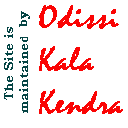Using
the body as a medium of communication, the expression
of dance is perhaps the most intricate and developed,
yet easily understood art form. Dance in India has
seeped into several other realms like poetry,
sculpture, architecture, literature, music and
theatre. The earliest archaeological evidence is a
beautiful statuette of a dancing girl, dated around
6000 B.C. Bharatha's Natya Sastra (believed to be
penned between second century B.C. and second century
A.D.) is the earliest available treatise on
dramaturgy. All forms of Indian classical dances owe
allegiance to Natya Sastra, regarded as the fifth
Veda. It is said that Brahma, the Creator, created
Natya, taking literature from the Rig Veda, song from
the Sama Veda, abhinaya or expression from the Yajur
Veda and rasa or aesthetic experience from the
Atharvana Veda. Temple panel, Orissa
It
also contains deliberations on the different kind of
postures, the mudras or hand formations and their
meanings, the kind of emotions and their
categorisation, not to mention the kind of attire,
the stage, the ornaments and even the audience. All
dance forms are thus structured around the nine rasas
or emotions, hasya (happiness), krodha (anger),
bhibasta (disgust), bhaya (fear), shoka (sorrow),
viram (courage), karuna (compassion), adbhuta
(wonder) and shanta (serenity). All dance forms
follow the same hand gestures or hasta mudras for
each of these rasas. The dances differ where the
local genius has adapted it to local demands and
needs.
Indian
dance is a blend of nritta - the rhythmic elements,
nritya - the combination of rhythm with expression
and natya - the dramatic element. Nritta is the
rhythmic movement of the body in dance, pure dance.
It does not express any emotion. Nritya is usually
expressed through the eyes, hands and facial
movements. Nritya combined with nritta makes up the
usual dance programmes. Nritya comprises abhinaya,
depicting rasa (sentiment) and bhava (mood).To
appreciate natya or dance drama, one has to
understand and appreciate Indian legends. Most Indian
dances take their themes from India's rich mythology
and folk legends. Hindu gods and goddesses like
Vishnu and Lakshmi, Rama and Sita, Krishna and Radha
are all depicted in classical Indian dances. Each
dance form also draws inspiration from stories
depicting the life, ethics and beliefs of the Indian
people.
The
fascination for Indian dance all over the world is
indicative of the deep-felt need to use the human
body to express and celebrate the great universal
truths. Indian dance does just that in a heightened,
reverential form. Also, since dance is physical and
visual, it illuminates India's culture in a direct
manner, playing on the sensibilities of the onlooker.
Thus, those who are attracted to India will find the
idiom of dance the best introduction to India's rich
ethos and traditions.
One
of the most enduring symbols of India is the figure
of Shiv Nataraj or the dancing Shiva. Shiva's cosmic
dance is believed to encompass creation,
preservation, and destruction and this idea has been
embedded in Hindu thought and ritual since the dawn
of civilisation.
In
India, dance and music pervade all aspects of life
and bring colour, joy and gaiety to a number of
festivals and ceremonies. In fact, dance and music
are tied inextricably to festivity of any kind.
